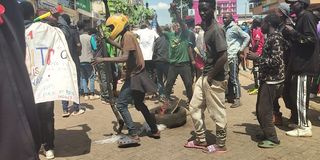
Protesters block the Kisii -Hospital road in Kisii town on june 27, 2024.
A reader, Daniel Magata of Naivasha writes to say NMG gave Gen Z “too much oxygen” in its coverage of their protests. And that is why, he says, “the demonstrators thought they could storm Parliament, burn and destroy property, without consequences.” Mr Magata makes an arguable point. See his letter under the “Readers Have Their Say” column.
However, as they say, all is well that ends well. President William Ruto on Wednesday agreed to “withdraw” the controversial 2024 Finance Bill, as demanded by the Gen Z demonstrators. It was a moment of victory for the Gen Z demonstrators, after their shameful storming of Parliament.
The media coverage played an important part in shaping public perception about the Gen Z and the demonstrations. The demonstrators were portrayed as peaceful, bold, fearless and techno-savvy. Taifa Leo captured the glamourisation of the Gen Z demonstrator in its banner headline of June 20. “WALICHOKOZA NYUKI” said the all caps headline.
“This generation of activists distinguishes itself through its boldness, dedication to justice, and adept use of technology to amplify their voices—a testament to their determination to shape a more equitable future,” said a Daily Nation story on June 21.
In a video that went viral, Anita Barasa, a 17-year-old activist, told Opposition leader Raila Odinga not to join the Gen Z demonstrations, and that it was okay for him to retire from demonstrations. In an interview with the NTV on June 21, she repeated the refrain that glorified the Gen Z demonstrations: “Baba please stay at home. It’s our turn.”
Gen Z protest
A BBC podcast, “Kenya’s Gen Z protest: What are they about?” released on June 21, described Kenya’s Gen Z as people who “know their rights” and “are an extremely intellectual generation.”
An innocent statement made in a special occasion but amplified by the media contributed to the idealisation of Gen Z demonstrations. Archbishop Jackson ole Sapit was reported saying to a congregation in Nyahururu on June 23: “My son left me in the car to join the protests. He jumped out and said, I’m going to my agemates.”
Nation opinion writers were generous with their comments. In his article, “Gen Z revolt nation’s awakening” (Daily Nation, June 20), Mutuma Mathiu said it looks like Kenya’s culture of struggle and rebellion “is reborn in our children.”
Gabriel Oguda, in his article “Call your Member of Parliament: A letter of solidarity with all Gen Zs in Kenya” (Daily Nation, June 21), paid homage to the “courageous gang,” strategising “how to bring down the walls of Babylon.” He urged them “to create the politics of Kenya in your own image….You have our full support all the way. Go, get ‘em!”
Macharia Gaitho, in his article “Wise move on protests, Mr President,” (Daily Nation, June 25), said we “could be on the cusp of a revolutionary moment in a youth-led protest movement seeking nothing less than uprooting of the entire edifice….Anyone who doesn’t see this is living in fool’s paradise.”
All of those statements tended to romanticise the demonstrations. The media looked like they were the cheerleaders. While they played an important role in informing the public about this demographic and providing valuable insights into the issues they were protesting, they should have considered the risk of adding fuel to the demonstrations.
Storming of Parliament
Painting a picture of the storming of Parliament by the demonstrators, the Daily Nation said in an editorial on June 25: “Precious lives have been lost, limbs maimed, and bucket-loads of blood spilled. The hallowed institution of Parliament was set on fire and breached in a manner never seen before in independent Kenya.”
Media coverage, in particular live television coverage, can easily contribute to escalating protests and belligerence of the demonstrators. The vivid and real-time portrayal of the demonstrations can also result in increasing the numbers of protestors, heightening their visibility, and sense of solidarity, and rightness of their cause.
It was important for the media to avoid over-romanticising the demonstrations and Kenya’s Gen Z. The media shouldn’t have portrayed them in an idealised way, sensationalising or exaggerating their qualities and accomplishments.
Reporters, as opposed to opinion writers, shouldn’t be seen as a participants in the events they cover. They should use neutral language and avoid statements that could be perceived as biased, either in favour of or against the protesters.
The Public Editor is an independent news ombudsman who handles readers’ complaints on editorial matters including accuracy and journalistic standards. Email: [email protected]. Call or text 0721989264








